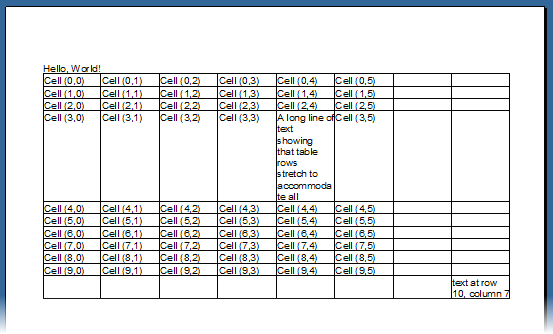在文档中,表格是最有用的功能之一。表格既可以将数据以表格的形式展现出来,也可以用来为文档中其他元素提供布局。C1PrintDocument 控件提供了全功能的表格。在本节,你会学习如何开始使用表格。我们会以C1PrintDocument 控件快速入门中创建的“Hello World”范例应用程序为基础,在其中添加一个表格。
制作简单的表格:
 |
注意:文章中的范例代码片段都是假设已经在使代码文件中用了"using C1.C1Preview;" 指令(这是C#语法,其他语言也有等效的写法),因此我们可以只使用类名(例如RenderText)而不必使用完全限定类型名(C1.C1Preview.RenderText)。 |
- 打开你在C1PrintDocument控件快速入门教程中创建的HelloWorld应用程序(或者你也可以根据上一节的描述创建一个新的应用程序)
- 切换到代码视图,然后在Form_Load事件处理程序(如果不存在则创建一个)中添加下面的代码,将它们放在调用Generate方法的代码之前:
Visual Basic
Visual Basic 拷贝代码Dim rt As New RenderTable() Me.C1PrintDocument1.Body.Children.Add(rt) Dim row As Integer = 0 Do While (row < 10) Dim col As Integer = 0 Do While (col < 6) rt.Cells.Item(row, col).Text = String.Format("Cell ({0},{1})", row, col) col += 1 Loop row += 1 LoopC#
C# 拷贝代码RenderTable rt = new RenderTable(); this.c1PrintDocument1.Body.Children.Add(rt); for (int row = 0; row < 10; ++ row) { for (int col = 0; col < 6; ++ col) { rt.Cells[row, col].Text = string.Format("Cell ({0},{1})", row, col); } } -
不要忘记在文档中调用Generate方法
Visual Basic
Visual Basic 拷贝代码Me.C1PrintDocument1.Generate()
C#
C# 拷贝代码this.c1PrintDocument1.Generate();
运行程序看一下
预览中显示的文档会看起来跟下图很相似

这个简单的例子展示了在C1PrintDocument控件中使用表格的几个重要方面的内容:
- 表格是由RenderObject类派生的RenderTable 类来表示的。
- 表格遵循在Microsoft Excel中使用的模型:它们的尺寸在初始化的时候是不限的,表格在渲染时的实际尺寸是由拥有最大行和列号的有值单元格所确定。在我们的例子中,由于这个表格高度是10行,宽度是6列,因此拥有最大行和列索引值的单元格的位置是在(9,5)(索引值
从0开始计数)。如果你修改代码,例如在(10,7)位置的单元格上添加文本,表格就会变成11行8列。
-
Visual Basic
Visual Basic 拷贝代码rt.Cells(10, 7).Text = "text at row 10, column 7"
C#
C# 拷贝代码rt.Cells[10, 7].Text = "text at row 10, column 7";
- 默认情况下,表格没有可见的网格线(Report for Winforms 中的网格线术语是指用于画表格的线,跟画在渲染对象周围的边框不同)。在Form Load事件处理中添加下行代码来添加网格线(用0.5 pt的钢笔线画):
Visual Basic
Visual Basic 拷贝代码rt.Style.GridLines.All = LineDef.Default
C#
C# 拷贝代码rt.Style.GridLines.All = LineDef.Default;
? 默认情况下,表格的宽度与它父级对象在客户端呈现的宽度一致(这个例子中是整个页面),并且每列的宽度等分。行的高度则是自动分配的。因此,如果你添加一行,并在其中任意一个单元格中添加一串长文本,你会发现单元格所属的行会自动向下扩展来容纳全部的文本内容。例如,在我们的例子中添加下方的代码就会生成如下图一样的表格(这个表格包含了上文描述的两个改动)
Visual Basic
Visual Basic 拷贝代码rt.Cells(3, 4).Text = "A long line of text showing that table rows stretch " + "to accommodate all content."
C#
C# 拷贝代码rt.Cells[3, 4].Text = "A long line of text showing that table rows stretch " + "to accommodate all content.";

你可以参考创建上述文档的完整form load事件处理代码:
Visual Basic
Visual Basic 拷贝代码Private Sub Form1_Load(ByVal sender As System.Object, ByVal e As System.EventArgs) Handles MyBase.Load Me.C1PrintDocument1.Body.Children.Add(New RenderText("Hello, World!")) Dim rt As New RenderTable() Me.C1PrintDocument1.Body.Children.Add(rt) Dim row As Integer = 0 Do While (row < 10) Dim col As Integer = 0 Do While (col < 6) rt.Cells.Item(row, col).Text = String.Format("Cell ({0},{1})", row, col) col += 1 Loop row += 1 Loop rt.Cells(3, 4).Text = "A long line of text showing that table rows " + "stretch to accommodate all content." rt.Cells(10, 7).Text = "text at row 10, column 7" rt.Style.GridLines.All = LineDef.Default Me.C1PrintDocument1.Generate() End SubC#
C# 拷贝代码private void Form1_Load(object sender, EventArgs e) { this.c1PrintDocument1.Body.Children.Add(new RenderText("Hello, World!")); RenderTable rt = new RenderTable(); this.c1PrintDocument1.Body.Children.Add(rt); for (int row = 0; row < 10; ++row) { for (int col = 0; col < 6; ++col) { rt.Cells[row, col].Text = string.Format("Cell ({0},{1})", row, col); } } rt.Cells[3, 4].Text = "A long line of text showing that table rows " + "stretch to accommodate all content."; rt.Cells[10, 7].Text = "text at row 10, column 7"; rt.Style.GridLines.All = LineDef.Default; this.c1PrintDocument1.Generate(); }
查看其它
 全部展开
全部展开 全部折叠
全部折叠